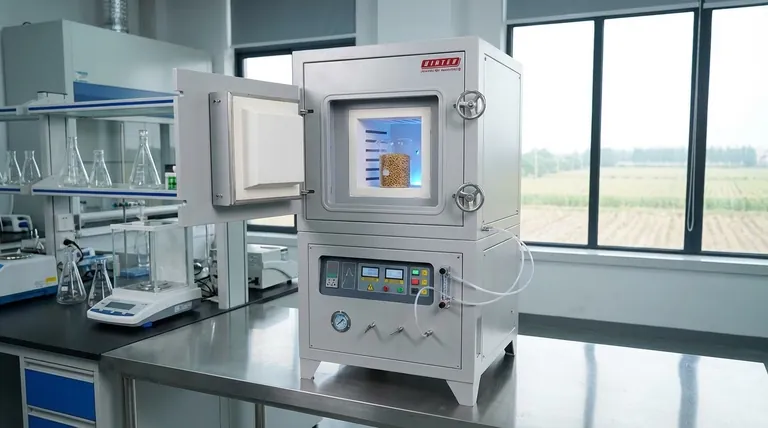In essence, controlled atmosphere storage is a method designed to alleviate the primary causes of spoilage in stored grains: the grain's own respiration, insect infestations, and the growth of molds. By precisely managing the gas composition within a sealed environment, it effectively puts these biological processes on hold.
The fundamental goal is to create an environment that is intentionally hostile to the organisms and processes that degrade stored products. By displacing oxygen with carbon dioxide, you can dramatically extend the life and preserve the quality of stored grains.

How Controlled Atmosphere Protects Stored Goods
A controlled atmosphere (CA) system is not merely about sealing a container; it's about actively changing the air inside to suppress specific biological threats.
Suppressing Grain Respiration
Grains are living seeds that continue to respire even after harvest. This process consumes the grain's stored energy (dry matter), produces heat and moisture, and slowly degrades its quality.
By increasing the concentration of carbon dioxide (CO2), this natural respiration process is significantly slowed down, preserving the grain's weight and nutritional value for a longer period.
Eliminating Insect Infestations
Nearly all insects that infest stored products are aerobic, meaning they require oxygen to survive. A controlled atmosphere directly targets this vulnerability.
When the oxygen (O2) concentration is reduced to below 2%, most insect species are unable to survive. This makes CA an extremely effective, chemical-free method of pest control, eliminating existing infestations and preventing new ones.
Inhibiting Mold and Fungal Growth
Molds and fungi are another major threat to stored grains, thriving in the presence of oxygen and moisture. These microorganisms can cause spoilage and produce harmful mycotoxins.
The low-oxygen, high-carbon dioxide environment created by CA storage is inhospitable to most molds, preventing their growth and protecting the grain from contamination.
Key Requirements and Trade-offs
Implementing a controlled atmosphere system is a significant technical undertaking with specific requirements and considerations.
The Need for Airtight Facilities
The entire principle relies on maintaining a specific gas composition. Therefore, the storage facility or silo must be completely airtight.
Any leaks will allow the controlled atmosphere to escape and oxygen to enter, rendering the entire system ineffective and wasting resources.
The Trade-off of Cost and Complexity
While highly effective, CA storage involves higher upfront capital costs for sealing facilities and installing gas generation and monitoring equipment.
It also requires a greater degree of technical management than simple storage, as the atmosphere must be continuously monitored and maintained to ensure its protective qualities.
Making the Right Choice for Your Goal
Controlled atmosphere storage is a powerful tool for preservation, but its application depends on your specific objectives.
- If your primary focus is long-term preservation of high-value grains: CA storage is one of the most effective methods available for maintaining quality and preventing loss over extended periods.
- If your primary focus is chemical-free pest control: This is a superior, non-fumigant solution for managing insect infestations in organic or sensitive products.
- If your primary focus is minimizing spoilage from mold and moisture: The low-oxygen environment is a powerful inhibitor of fungal growth, directly protecting your inventory.
Ultimately, adopting controlled atmosphere storage is a proactive investment in preserving the fundamental value of your stored goods.
Summary Table:
| Threat Alleviated | How Controlled Atmosphere Helps | Key Gas Change |
|---|---|---|
| Grain Respiration | Slows down the process, preserving dry matter and nutritional value. | Increased CO2 |
| Insect Infestations | Kills pests by removing their oxygen supply; a chemical-free solution. | Reduced O2 (<2%) |
| Mold & Fungal Growth | Creates an inhospitable environment, preventing spoilage and toxins. | Reduced O2, Increased CO2 |
Ready to protect your valuable grains with precision-controlled environments? KINTEK specializes in laboratory equipment and consumables for advanced storage solutions. Our expertise helps you implement effective preservation strategies to extend grain life, eliminate pests, and prevent spoilage. Contact KINTEK today to discover how we can support your laboratory's specific needs in grain storage and quality preservation.
Visual Guide

Related Products
- 1200℃ Controlled Atmosphere Furnace Nitrogen Inert Atmosphere Furnace
- 1700℃ Controlled Atmosphere Furnace Nitrogen Inert Atmosphere Furnace
- 1400℃ Controlled Atmosphere Furnace with Nitrogen and Inert Atmosphere
- Controlled Nitrogen Inert Hydrogen Atmosphere Furnace
People Also Ask
- How do you make an inert atmosphere? Master Safe, Pure Processes with Inerting
- Can nitrogen gas be heated? Leverage Inert Heat for Precision and Safety
- What is the purpose of inert atmosphere? A Guide to Protecting Your Materials and Processes
- How we can develop inert atmosphere for a chemical reaction? Master Precise Atmospheric Control for Your Lab
- What gases are used in inert atmospheres? Choose the Right Gas for Non-Reactive Environments



